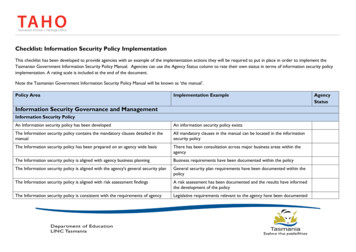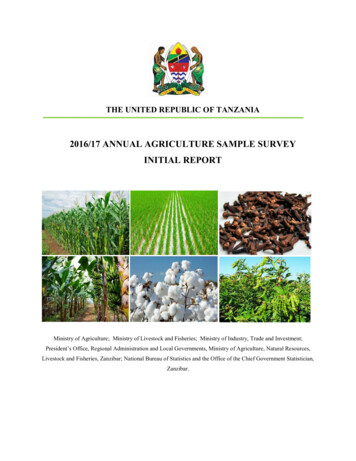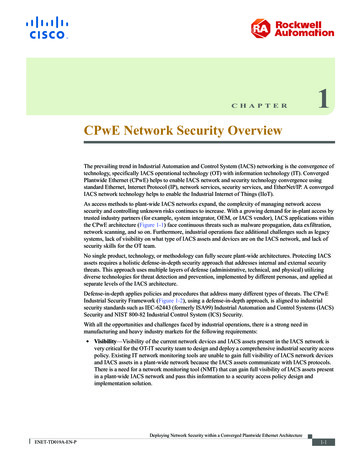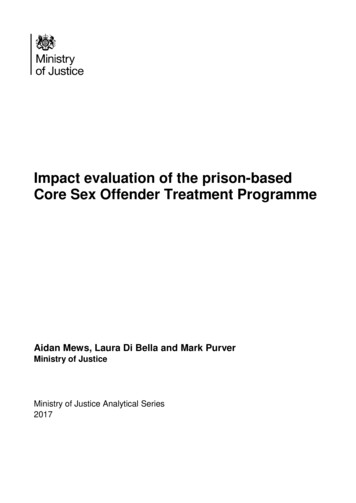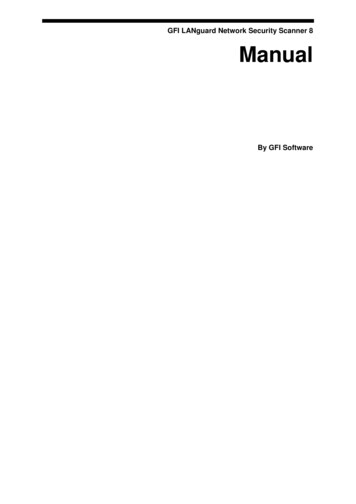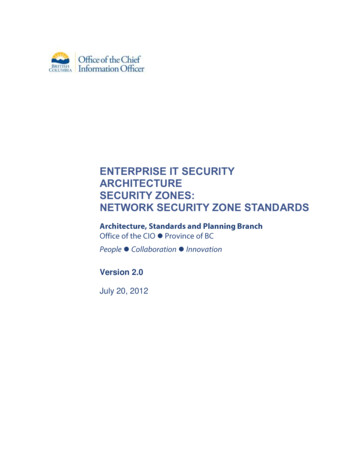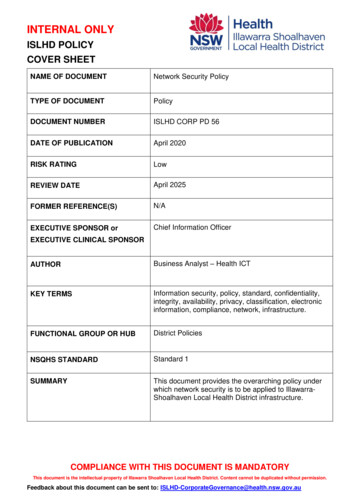
Transcription
INTERNAL ONLYISLHD POLICYCOVER SHEETNAME OF DOCUMENTNetwork Security PolicyTYPE OF DOCUMENTPolicyDOCUMENT NUMBERISLHD CORP PD 56DATE OF PUBLICATIONApril 2020RISK RATINGLowREVIEW DATEApril 2025FORMER REFERENCE(S)N/AEXECUTIVE SPONSOR orChief Information OfficerEXECUTIVE CLINICAL SPONSORAUTHORBusiness Analyst – Health ICTKEY TERMSInformation security, policy, standard, confidentiality,integrity, availability, privacy, classification, electronicinformation, compliance, network, infrastructure.FUNCTIONAL GROUP OR HUBDistrict PoliciesNSQHS STANDARDStandard 1SUMMARYThis document provides the overarching policy underwhich network security is to be applied to IllawarraShoalhaven Local Health District infrastructure.COMPLIANCE WITH THIS DOCUMENT IS MANDATORYThis document is the intellectual property of Illawarra Shoalhaven Local Health District. Content cannot be duplicated without permission.Feedback about this document can be sent to: ISLHD-CorporateGovernance@health.nsw.gov.au
INTERNAL ONLYISLHD POLICYNetwork Security Policy1.ISLHD CORP PD 56POLICY STATEMENTIllawarra-Shoalhaven Local Health District (ISLHD) recognises that access to clinicaland corporate applications is necessary, for the safe and effective functioning of anevidence based integrated healthcare system.ISLHD has statutory and regulatory obligations concerning information security, ofwhich network security is a significant aspect.The purpose of the Network Security Policy is to describe the principles used tomanage and protect ISLHD assets when a network capable device is required to beconnected to the network infrastructure.This policy is a sub-policy to the ISLHD Information Security Policy - ISLHD CORP PD38. It is recommended this policy is not read in isolation.2.AIMSThe policy provides information security principles when using ISLHD digitalinfrastructure and supports applying Information Security (InfoSec) across the ISLHDorganisation.The Network Security Policy principles are: Apply the minimum information security controls to data transmission, ensuringsecurity of data in private and public facing networks and the protection ofdigital services from unauthorised access. Ensure information security controls are applied on devices which enablecommunications across wired and wireless environments such as routers,switches, firewalls, load balancers, Intrusion Detection Devices (IDS), WirelessAccess Points (WAPs) and any other devices that provide a networkconnection. By utilising an on-boarding procedure for each network device which mustexecute to ensure appropriate risk and administration activities are carried outprior to attaching the device or ICT service.Assistance and guidance can be sought by contacting Health ICT (HICT) by logging acall with the eHealth State Wide Service Desk (SWSD) or via SARA.3.TARGET AUDIENCEThis policy applies to all parties including permanent, temporary and casual staff ofIllawarra-Shoalhaven Health, staff seconded from other organisations and contingentworkers including labour hire, service providers, professional services contractors andconsultants, who may utilise ISLHD infrastructure and/or access ISLHD systems andapplications (including systems provided by external providers such as eHealth) withrespect to the security and privacy of information.Revision 1.0ISLHD CORP PD 56DX20/72April 2020Page 1 of 17This document becomes uncontrolled when printed or downloaded. This document is the intellectual property ofIllawarra Shoalhaven Local Health District and cannot be duplicated without permission.
INTERNAL ONLYISLHD POLICYNetwork Security Policy4.ISLHD CORP PD 56NETWORK SECURITY POLICY SCOPEThe policy applies to all digital and analogue network infrastructure installed within theDistrict premises, which is used for the transmission of data.No distinction is made as to the electronic medium on which the information istransmitted, as the policy is intended to be technology independent.A network device can be one of several types of equipment namely routers, switches,firewalls, intrusion detection devices and such. Network devices when configured withsoftware, offer a service and are commonly referred to as network service device orservice device.To ensure that the appropriate operational information security controls are applied tothe management of the network, managers should separate network operationalresponsibilities from network security responsibilities.For example; staff that support day-to-day operations of the network should not be thesame staff that perform network security function. If responsibility separation is notpossible, mitigation actions such as recording of network support staff actions whenperforming a security functions and the reviewing of the recorded log files or othersupervisory actions must be executed.Department managers or users that operate their own network, must adhere to thesame information security management, controls and principles that are applied to theDistrict general network.The following principles apply to the network infrastructureRevision 1.0 Access to network services is to be restricted to verified users, devices andapplications; Where an automated process is used to connect remote systems, a suitablysecure authentication mechanism which meets the District’s information securitystandards must be used in the process; Network connections with external environments must prevent unauthorisedaccess; Cross boundary access between internal and external networks is to be secureand must use an information security approved authentication method at theentry points; Remote access to ISLHD systems is to be managed as outlined in ISLHD UserAccess Management Policy – ISLHD CORP PD 60; Network devices are not to be accessible or managed remotely from the internet.All access to the devices must only be via internal connections.ISLHD CORP PD 56DX20/72April 2020Page 2 of 17This document becomes uncontrolled when printed or downloaded. This document is the intellectual property ofIllawarra Shoalhaven Local Health District and cannot be duplicated without permission.
INTERNAL ONLYISLHD POLICYNetwork Security Policy No local user accounts are configured on any network service device and mustuse approved authentication mechanisms for all user authentication. Telnetwithout a Virtual Private Network (VPN) application must not be used. The administration and service passwords on network service devices must bekept in a secure encrypted form and must be changed from the default whenbeing configured. Information security has defined a set of services or features which must bedisabled as the default, until secure configuration is implemented as describedin Appendix A: The following services should be disabled unless a business justification isprovided and approval from the Information Security Governance Committee(ISCG) is given. Approvals from the ISGC can be sought by logging a call withthe eHealth SWSD or via SARA: oCisco or other discovery protocols;oDynamic trunking;oScripting environments, such as the TCL shell;The following services must be configured;oPassword-encryption;oNetwork Time Protocol (NTP) configured to a LHD standard source; All routing updates shall be done using secure routing updates. The Simple Network Management Protocol (SNMP) community strings mustfollow the District approved strings. Default strings, such as public or privatemust be removed. SNMP must be configured to use the most secure version of the protocolallowed for by the combination of the device and management systems. Access control lists must be used to limit the source and type of traffic that canterminate on the device itself. Access control lists for transiting the device are to be added as business needsarise. The router must be included in the corporate enterprise management systemwith a designated point of contact. Each network service device, where applicable, must have a warning statementpresent for all forms of login, whether remote or local such as the examplebelow:oRevision 1.0ISLHD CORP PD 56"UNAUTHORISED ACCESS TO THIS NETWORK DEVICE ISPROHIBITED. You must have explicit permission to access or configurethis device. All activities performed on this device may be logged, andviolations of this policy may result in disciplinary action, and may beISLHD CORP PD 56DX20/72April 2020Page 3 of 17This document becomes uncontrolled when printed or downloaded. This document is the intellectual property ofIllawarra Shoalhaven Local Health District and cannot be duplicated without permission.
INTERNAL ONLYISLHD POLICYNetwork Security PolicyISLHD CORP PD 56reported to law enforcement. There is no right to privacy on this device.Use of this system shall constitute consent to monitoring."Revision 1.0 Telnet must never be used across any network to manage a router, unlessthere is a secure communications tunnel protecting the entire communicationpath. Dynamic routing protocols must use authentication in routing updates sent tonetwork neighbours. Password hashing for the authentication string must beenabled when supported. The ISLHD ICT router configuration standard defines the category of sensitiverouting and switching devices, and require additional services or configurationon sensitive devices including:oThe TCP/IP access list accounting must be enabled to show the type ofaccess to remote connections;oDevice logging of activities; andoIncoming packets at the router sourced with invalid addresses, such asRFC1918 addresses, or those that could be used to spoof networktraffic shall be dropped. Router console and modem access must be restricted by additional securitycontrols. Assistance can be sought from HICT by lodging a call to the eHealthSWSD or via SARA. All backups of network devices must be encrypted to ensure privacy andconfidentiality of the backed up information. Network service device operating systems need to be genuine, licensed and beup to date. Devices or operating systems must not be tampered with tocircumvent security, policy and configuration controls that have been enforced.Any such tampering with the device is strictly forbidden. When not being used Wi-Fi and Bluetooth must be turned off to preventdiscovery by third parties. All Bluetooth communications should use a uniquepass-code. It is not recommended to connect to unsecured Wi-Fi access points,if in doubt, do not connect. Network device passwords must be changed at least annually or morefrequently as per the risk assessment. Restrict access to network devices to an approved list of personnel. Ensure that the current software revision levels of network equipment andserver environments are in compliance with the security configurationrequirements.ISLHD CORP PD 56DX20/72April 2020Page 4 of 17This document becomes uncontrolled when printed or downloaded. This document is the intellectual property ofIllawarra Shoalhaven Local Health District and cannot be duplicated without permission.
INTERNAL ONLYISLHD POLICYNetwork Security PolicyISLHD CORP PD 56The following principles are in place to ensure that appropriate controls for theoperation of the devices and the network infrastructure.Revision 1.0 Prior to attaching a network service device to the District network infrastructure,the device must comply with ISLHD ICT information security controls andstandards as per ISO27001:2013 Information Security Management System andAustralian Signals Directorate (ASD) Essential 8 to ensure the security of ISLHDdigital assets. The device must undergo an on-boarding procedure of securing and testing. Arequest can be lodged via the eHealth State Wide Service Desk (SWSD) or viaSARA. All data traversing the network must have the appropriate information securitycontrols applied as outlined in ISLHD Labelling and Classification of Digital DataPolicy – ISLHD CORP PD 55. Information passing across ISLHD and public networks must be protected fromcompromise corresponding with the risk employing encryption where required. Arisk assessment on the data must be conducted prior to commencement of theservice. The risk assessment methodology to be used is outlined in the NSWMinistry of Health Policy Directive PD2015 043 – Enterprise-wide RiskManagement Policy and Framework. Network environments should be segregated corresponding to the risk identifiedthat may be experienced by the asset using the NSW Ministry of Health PolicyDirective PD2015 043 – Enterprise-wide Risk Management Policy andFramework; Network service devices must be registered in the District’s ConfigurationManagement Database (CMDB). To register the devices, a call can be lodgedwith the eHealth SWSD or via SARA. All network infrastructure and service device changes are to be managed via thedistrict Change Control procedure. To register a change, a call can be lodgedwith the eHealth SWSD or via SARA. Information Security Controls must be implemented to protect informationnetwork service devices from illegal software. This includes, for example,software designed to circumvent any security controls; i.e. network servicedevices must not be loaded with unlicensed software or software not intended forthe device. Network service devices must be monitored and/or be capable of monitoring forsigns of malicious activity. Connections found to be responsible for suspectedmalicious activity are to be disconnected from the network. Network service devices must enforce a local connection policy based on a riskassessment and business requirements. Only approved data transmission protocols are to be utilised for networkconnectivity.ISLHD CORP PD 56DX20/72April 2020Page 5 of 17This document becomes uncontrolled when printed or downloaded. This document is the intellectual property ofIllawarra Shoalhaven Local Health District and cannot be duplicated without permission.
INTERNAL ONLYISLHD POLICYNetwork Security PolicyISLHD CORP PD 56 Network service devices must be configured in a secure manner with the defaultposition being of the highest security position. Trust mechanisms on the network service devices must be established betweendevices to support the secure transmission and receipt of information. Periodic penetration testing must be carried out to determine adequacy ofnetwork protection, based upon the risk assessment and threat level. Periodic testing of network service devices security must be carried out todetermine adequacy of system protection, based upon the risk assessment andthreat level. Network service devices must be wiped of any stored data and securelydisposed of at the end of their life cycle.Bring Your Own Devices (BYODs) that utilise Bluetooth must be on-boarded prior toaccessing ISLHD digital resources, please refer to the ISLHD Policy Directive -ICTBring Your Own Device Policy ISLHD CORP PD 45 for further information.Pins and PairingWhen pairing your Bluetooth unit to your Bluetooth enabled equipment (i.e. phone,laptop, etc.), ensure that you are not in a public area where your PIN can becompromised.If your Bluetooth enabled device asks for you to enter your PIN after you have initiallypaired it, you must refuse the pairing request and report it to the State Wide ServiceDesk (SWSD) immediately.Device Security SettingsAll Bluetooth devices shall employ ‘security mode 3’ option which encrypts traffic inboth directions, between your Bluetooth device and its paired equipment. Use a minimum PIN length of 8. A longer PIN provides more security; Set the Bluetooth device to hidden or non-discoverable mode; Only activate Bluetooth when it is needed; and Ensure device firmware is up-to-date.Unauthorised Use Principles of BluetoothThe following is a list of unauthorised uses of ISLHD owned Bluetooth devices:Revision 1.0 Eavesdropping, device Identification spoofing, Denial of Service (DoS) attacks,or any form of attacking other Bluetooth enabled devices. Using ISLHD owned Bluetooth equipment on non ISLHD owned Bluetoothenabled devices. Unauthorised modification of Bluetooth devices for any purpose.ISLHD CORP PD 56DX20/72April 2020Page 6 of 17This document becomes uncontrolled when printed or downloaded. This document is the intellectual property ofIllawarra Shoalhaven Local Health District and cannot be duplicated without permission.
INTERNAL ONLYISLHD POLICYNetwork Security PolicyISLHD CORP PD 56User ResponsibilitiesIt is the Bluetooth user's responsibility to comply with the principles within this policyincluding: Bluetooth mode must be turned off when not in use on your device. ISLHD data marked Confidential or above must not be transmitted or stored onBluetooth enabled devices. All exemptions must seek approval via theInformation Security Governance Committee (ISCG) by lodging a request viathe eHealth SWSD. Bluetooth users must only access ISLHD information systems using approvedBluetooth device hardware, software, solutions, and connections. Bluetooth device hardware, software, solutions, and connections that do notmeet the standards of this policy shall not be authorised for deployment. Bluetooth users must act appropriately to protect information, network access,passwords, cryptographic keys, and Bluetooth equipment. Bluetooth users are required to report any misuse, loss, or theft of Bluetoothdevices or systems immediately to ISLHD ICT or the SWSD.HICT with ISLHD Internal Audit (IA) may perform random audits to ensure compliancywith this and other information security policies. In the process of performing suchaudits, HICT or any other staff must not eavesdrop on any phone conversation.Security changes are defined as changes to network service device, that may have animpact on the overall security of the network and therefore changes must follow theISLHD ICT change management procedure (T15/38106). Engagement of changemanagement can be done by lodging a call with the eHealth SWSD.Network service devices must, where possible, be monitored to ensure that thepatches and firmware upgrades have been applied. HICT may use an automatedmechanism for reporting the patching compliance of systems that are in the ISLHDdomain.Prior to attaching a device, a review must be conducted to establish the suitability andcapability of the device with regards to monitoring. Assistance can be sought bylodging a call with the eHealth SWSD or via SARA.Network service devices that cannot be actively monitored must have a scheduledetermined by the risk posture that would determine the frequency of the checks.IT specialists that manage network devices not under HICT management areresponsible for confirming the patch compliance of their systems and taking promptremedial action where Network devices are found to be not fully up to date.Revision 1.0ISLHD CORP PD 56DX20/72April 2020Page 7 of 17This document becomes uncontrolled when printed or downloaded. This document is the intellectual property ofIllawarra Shoalhaven Local Health District and cannot be duplicated without permission.
INTERNAL ONLYISLHD POLICYNetwork Security PolicyISLHD CORP PD 56Security patching status must be reported to the ISLHD Information SecurityGovernance Council and HICT Director at least annually in line with the NSWGovernment mandated compliance reporting as specified in the NSW GovernmentCyber Security Policy.Network service device logs must be monitored for malicious activity on a routineschedule, as set by the risk assessment and threat landscape.Other network traffic may be logged as necessary for troubleshooting and resolution ofnetwork issues. Automated scans for unencrypted sensitive data are conducted as setby the risk assessment and threat landscape with findings logged for appropriatemanagement.Only malicious or extraordinary activity is to be logged, i.e. management by exception.These measures must not be used for tracking and/or monitoring an individual’snetwork activity.Confidentiality of all information gathered as a result of network monitoring will bemaintained at all times.Access to information obtained through network monitoring will be limited to authorisedstaff and in the event of a breach requiring an investigation, ISLHD executive mayinvolve Workforce, legal counsel, law enforcement and Internal Audit. Data obtainedvia network monitoring must be kept in a protected storage area.Authorised staff must use network monitoring devices only to: Detect known patterns of attack or compromise; Troubleshoot and analyse network-based problems; and Ascertain network-based anomalies to determine the security risk to the ISLHD.All monitoring shall be as narrow in scope as possible.Authorised staff may not exceed specified scope of monitoring (for example, users,address ranges, protocols, and signatures). Only ISLHD ICT or HICT Network teamswith permission from the Health ICT Director or the ISLHD CIO may monitor publicnetworks and inter and intra campus networks.Personnel authorised to analyse network traffic shall not disclose any informationrealised in the process without approval of the ISLHD CIO or ICT Director.No authorised personnel shall use network monitoring devices to monitor employeeelectronic transmissions for job performance evaluation, or as part of an unofficialinvestigation.The ISLHD CIO or HICT Director will be the contact for resolution of security-relatedanomalies or other suspicious activity noticed by representatives of ISLHD ICT or HICTNetwork teams or in other departments.All monitoring points will be architected, approved, and configured by ISLHD ICT orHICT Network teams and the HICT Security Architect. Monitoring points andassociated devices may not be extended physically or virtually (such as through aVPN) or changed without written approval from the CIO or HICT Director. ISLHD ICTRevision 1.0ISLHD CORP PD 56DX20/72April 2020Page 8 of 17This document becomes uncontrolled when printed or downloaded. This document is the intellectual property ofIllawarra Shoalhaven Local Health District and cannot be duplicated without permission.
INTERNAL ONLYISLHD POLICYNetwork Security PolicyISLHD CORP PD 56or HICT Network teams shall maintain written records of all monitoring points,architectures, and agreements.Monitored data and usage logs will not be stored past the period of active investigation.ISLHD ICT, the HICT Director or HICT Network teams may store incident related dataas required by law. Unrelated monitored data may not be stored by anyone except asrequired by law.ISLHD ICT, the HICT ICT Director or HICT Network teams may store aggregated dataand usage logs for operational, compliance, and statistical purposes.Monitoring data stores and log files must not be accessible from the public Internet.ISLHD ICT or HICT Network team personnel must show due care in protection,handling, and storage of all monitored data and logs.ISLHD ICT, the HICT Director or HICT Network teams have the authority todiscontinue service to any network or network device that: Is in violation of this policy; Has demonstrated an operational hindrance or threat to ISLHD digitalinfrastructure; or Is a threat to the LHD intranet community in general.In such cases, ISLHD ICT, the HICT Director or HICT Network teams shall notify thelocal IT-Networking custodian of the disconnection.In less threatening situations, ISLHD ICT, the HICT Director or HICT Network teams ordelegate will contact the local network administrator and inform them of specific actionsthat must be taken to avoid imminent disconnection. If corrective actions are notimplemented as soon as possible, ISLHD ICT, HICT Network or the HICT Director maydiscontinue service.All normal requests for monitoring assistance from external agencies or internaldepartments must be coordinated through the State Wide Service Desk (SWSD).HICT will be responsible for the architecture and operations of all network facilities/functions required for lawful Intercept assistance and compliance, and will beresponsible for executing all requests as coordinated through the HICT DeputyDirector. Departments must comply with all HICT requirements and assist HICTNetworking to fulfil its obligations.5.WIRELESS DEVICESAll wireless infrastructure devices that reside at an ISLHD site and connect to anISLHD network, or provide access to information classified as ISLHD Confidential orhigher, must:Revision 1.0 Abide by the standards specified in the HICT Wireless CommunicationStandard; Be installed, supported, and maintained by an approved support team; Use ISLHD approved authentication protocols and infrastructure;ISLHD CORP PD 56DX20/72April 2020Page 9 of 17This document becomes uncontrolled when printed or downloaded. This document is the intellectual property ofIllawarra Shoalhaven Local Health District and cannot be duplicated without permission.
INTERNAL ONLYISLHD POLICYNetwork Security PolicyISLHD CORP PD 56 Use ISLHD approved encryption protocols; Maintain a hardware address (Media Access Control - MAC address) that canbe registered and tracked; Not interfere with wireless access deployments maintained by other supportdepartments; Use Extensible Authentication Protocol-Fast Authentication via SecureTunnelling (EAP-FAST), Protected Extensible Authentication Protocol (PEAP),or Extensible Authentication Protocol-Translation Layer Security (EAP-TLS) asthe authentication protocol; Use Temporal Key Integrity Protocol (TKIP) or Advanced Encryption System(AES) protocols with a minimum key length of 128 bits;The following directives apply with respect to wireless networks: Wireless Access Points (WAPs) connected to the ISLHD network must beapproved by HICT before installation. To register an installation, a call can belodged with the eHealth SWSD or via SARA. All Personnel are strictly prohibited from installing their own WAPs within theISLHD network; Controls over WAPs are to follow the same requirements as for the wirednetwork including, but not restricted to, network registration, malware software,up-to-date patches, and strong passwords that comply with ISLHD PasswordPolicy and Standards; Systems using WAPs to access the ISLHD network must have current antimalware software and up-to-date patches installed; Access to ISLHD infrastructure via WAPs must utilise strong authentication andencryption; Wireless communications between ISLHD devices and networks must beencrypted; Wireless implementations must support a hardware address that can beregistered and tracked, i.e. a Media Access Control (MAC) address; Effective physical security is to be applied to hardware associated with WAPs; WAPs are to be periodically scanned for vulnerabilities to assess the base levelof security needed relevant to the network risk.All laboratory wireless infrastructure devices that provide access to ISLHD, mustadhere to Section 5.1 above. Laboratory and isolated wireless devices that do notprovide general network connectivity to the ISLHD network must: Revision 1.0Be isolated from the LHD network (that is it must not provide any LHDconnectivity).ISLHD CORP PD 56DX20/72April 2020Page 10 of 17This document becomes uncontrolled when printed or downloaded. This document is the intellectual property ofIllawarra Shoalhaven Local Health District and cannot be duplicated without permission.
INTERNAL ONLYISLHD POLICYNetwork Security PolicyISLHD CORP PD 56 Not interfere with wireless access deployments maintained by the LHD wirelessdevices. Set the Service Set Identifier (SSID) for the laboratory device different fromISLHD LHD wireless device SSID.There has been recorded incidents of hackers monitoring home networks as anavenue to gain access to the District. As many LHD staff log in from home using theirown wireless networks, precautions must be taken to mitigate the risk.Home wireless infrastructure devices that are used to access to the ISLHD network,must have sufficient security controls enabled to prevent external parties from gainingaccess and viewing network data. The following are four configuration settings in yourhome router that must be changed to protect your network: Enable Wi-Fi Protected Access Pre-shared Key (WPA-PSK), EAP-FAST,PEAP, or EAP-TLS; When enabling WPA-PSK, configure a complex shared secret key (at least 8characters) on the wireless client and the wireless access point; Change the default SSID name; and Change the default Administrator password to a complex password.If you do not have the skill or knowledge to make the changes, it is advisable toengage your local neighbourhood IT specialist or your telecommunications provider toassist.6.EXEMPTIONSAny exemptions to the Network Security Policy must be approved by the ChiefInformation Officer (CIO) or HICT Deputy Director after undergoing a risk assessment.Written approval for exemption must be completed through a Brief and must berecorded within the Document Management System (i.e. Content Manager) as per theISLHD Records Management Standard.7.DEFINITIONSAdvanced Encryption System (AES):The Advanced Encryption Standard (AES) is a specification for the encryption ofelectronic data. AES is based on a design principle known as a substitution–permutation network, and is efficient in both software and hardware.BluetoothBluetooth is a short-range radio technology (or wireless technology) aimed atsimplifying communications among Internet devices and between devices and theInternet.Campus NetworkA campus network, campus area network, corporate area network or CAN is acomputer network made up of an interconnection of local area networks (LANs) withinRevision 1.0ISLHD CORP PD 56DX20/72April 2020Page 11 of 17This document becomes uncontrolled when printed or downloaded. This document is the intellectual property ofIllawarra Shoalhaven Local Health District and cannot be duplicated without permission.
INTERNAL ONLYISLHD POLICYNetwork Security PolicyISLHD CORP PD 56a limited geographical area. The networking equipment (switches, routers) andtransmission media (optical fibre, copper plant, Cat5 cabling etc.) are almost entirelyowned by the campus tenant / owner: an enterp
The Network Security Policy principles are: Apply the minimum information security controls to data transmission, ensuring security of data in private and public facing networks and the protection of digital services from unauthorised access. Ensure information security cont
